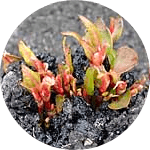Horsetail

The overview
Common Name: Field Horsetail / Common Horsetail
Latin name: Equisetum arvense
In Detail
- Horsetail is a deep-rooted native perennial with fast growing rhizomes.
- Spreads quickly via the rhizome or spores and creates dense stands of foliage.
- Not to be confused with Mare’s tail (Hippurus vulgaris) which is an aquatic plant of different species.
Who we help
We have a long track record of managing some of the most complex sites in the country and have worked with the Environment Agency on several large flood alleviation projects, as well as providing advice to the majority of house builders and developers in the UK.
Click here to view who we help







Identification
- Brown stem in Spring, turning green by Summer.
- Upright, fir-tree like shoots.
- Plants can grow up to 2ft in height.
- Jointed stems with the leaves at each joint
- Long and slender pointed green leaves
- No flowers
What’s the problem?
- Rapidity of growth and spread
- Damage to surrounding plant life
- Difficult to control by cultivation
Legislation *England
- The species is not currently listed as a Schedule 9 species under the Wildlife and Countryside Act 1981.
Control and removal of Horsetail
Below are some of the control methods that can be used.
Mechanical
- Plants can be dug out but it is essential that all the plant material is removed as the plant can re-grow from any small pieces of rhizome left behind.
Chemical treatment
- Infestations can be effectively treated with herbicide whilst the plants are actively growing.
- For best results, the plants should be lightly bruised before applying a suitable herbicide.
- Treatment can take a number of years to achieve eradication.
Other treatment options
- Regular cutting or weeding of the plant can reduce infestation if carried out over a number of years.
If you have concerns over Horsetail please contact our specialist surveyors. Treatment costs start from £380.00 + VAT.

Where we have worked
We operate nationwide with a Rapid Response Team on standby 7 days a week, to deal with the most urgent client enquiries.
We’re a dedicated team of professionals who share a great deal of experience. We invest heavily in the continual training of all our employees, ensuring you always have a highly qualified team working on your project with the latest industry accreditations.
Our process

1. Identify
Our first step is to identify if you have an invasive plant. For a quick ID, you can send us some photos. Alternatively, we can carry out a full site survey to confirm the extent of the infestation.

2. Solution
We will provide a range of treatment options individually tailored depending on your site requirements.

3. Quote
A detailed breakdown of costs for each phase of treatment will be provided, including on-going monitoring programmes with insurance backed guarantees.

4. Removal
Our experienced and professional in-house teams will carry out the treatment to the highest of standards to achieve full eradication. All works are carried out in accordance with the INNSA Code of Practice.

5. Treatment
A range of treatment solutions are available, from in-situ herbicide application to excavation and removal or burial. All carried out in-house by our experienced team.

